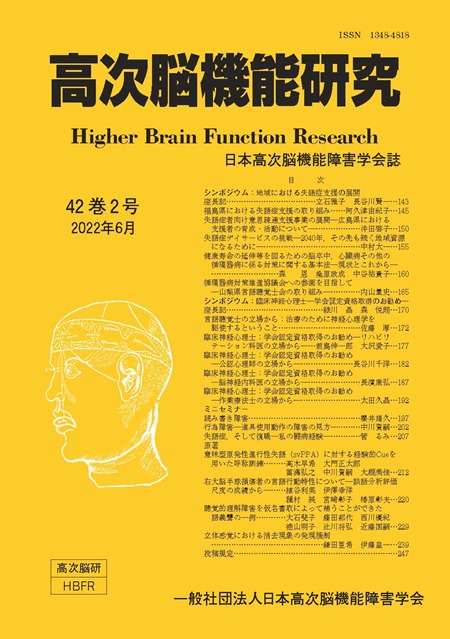Volume 42, Issue 2
Displaying 1-19 of 19 articles from this issue
- |<
- <
- 1
- >
- >|
Symposium : Supported Communication for Adults with Aphasia in the Community
-
2022 Volume 42 Issue 2 Pages 143-144
Published: June 30, 2022
Released on J-STAGE: August 30, 2022
Download PDF (211K) -
2022 Volume 42 Issue 2 Pages 145-149
Published: June 30, 2022
Released on J-STAGE: August 30, 2022
Download PDF (467K) -
2022 Volume 42 Issue 2 Pages 150-154
Published: June 30, 2022
Released on J-STAGE: August 30, 2022
Download PDF (549K) -
2022 Volume 42 Issue 2 Pages 155-159
Published: June 30, 2022
Released on J-STAGE: August 30, 2022
Download PDF (462K) -
2022 Volume 42 Issue 2 Pages 160-164
Published: June 30, 2022
Released on J-STAGE: August 30, 2022
Download PDF (395K) -
2022 Volume 42 Issue 2 Pages 165-169
Published: June 30, 2022
Released on J-STAGE: August 30, 2022
Download PDF (585K)
Symposium : Clinical Neuropsychologist : A Recommendation for Qualification
-
2022 Volume 42 Issue 2 Pages 170-171
Published: June 30, 2022
Released on J-STAGE: August 30, 2022
Download PDF (201K) -
2022 Volume 42 Issue 2 Pages 172-176
Published: June 30, 2022
Released on J-STAGE: August 30, 2022
Download PDF (652K) -
2022 Volume 42 Issue 2 Pages 177-181
Published: June 30, 2022
Released on J-STAGE: August 30, 2022
Download PDF (482K) -
2022 Volume 42 Issue 2 Pages 182-186
Published: June 30, 2022
Released on J-STAGE: August 30, 2022
Download PDF (394K) -
2022 Volume 42 Issue 2 Pages 187-191
Published: June 30, 2022
Released on J-STAGE: August 30, 2022
Download PDF (397K) -
2022 Volume 42 Issue 2 Pages 192-196
Published: June 30, 2022
Released on J-STAGE: August 30, 2022
Download PDF (353K)
Short Seminars
-
2022 Volume 42 Issue 2 Pages 197-201
Published: June 30, 2022
Released on J-STAGE: August 30, 2022
Download PDF (373K) -
2022 Volume 42 Issue 2 Pages 202-206
Published: June 30, 2022
Released on J-STAGE: August 30, 2022
Download PDF (332K) -
2022 Volume 42 Issue 2 Pages 207-211
Published: June 30, 2022
Released on J-STAGE: August 30, 2022
Download PDF (505K)
Original article
-
2022 Volume 42 Issue 2 Pages 212-219
Published: June 30, 2022
Released on J-STAGE: August 30, 2022
Download PDF (606K) -
2022 Volume 42 Issue 2 Pages 220-228
Published: June 30, 2022
Released on J-STAGE: August 30, 2022
Download PDF (423K) -
2022 Volume 42 Issue 2 Pages 229-238
Published: June 30, 2022
Released on J-STAGE: August 30, 2022
Download PDF (552K) -
2022 Volume 42 Issue 2 Pages 239-246
Published: June 30, 2022
Released on J-STAGE: August 30, 2022
Download PDF (526K)
- |<
- <
- 1
- >
- >|
